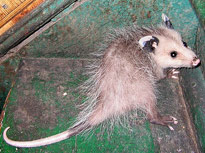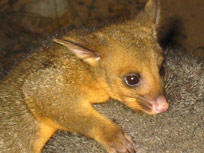Didelphimorphia & Didelphidae -- How many possums can there possibly be!
Didelphidae



Origins
Didelphimorphia means a creature with two("di") wombs("delphus"). This could apply to all marsupials, actually. People can be quite arbitrary in their latin naming conventions. Perhaps they found nothing quite extraordinary about this family of ..well..possums really. The Virginia Opossum is the original animal named opossum. The word comes from Algonquian wapathemwa and it means long snouted, ugly faced tasty thing. Opossums probably diverged from the basic South American marsupials in the late Cretaceous or early Paleocene.
Physical Characteristics
Restricted to North and South America, didelphids have radiated into a wide variety of forms. Most are omnivorous or carnivorous. Several species are arboreal; one is aquatic and has fully webbed hind feet. Didelphids can be found in most habitats from sea level to over 3000m, from dry thornscrub and grassland to tropical forest. The extinct relatives of didelphids were even more varied in their morphology and habits; one group specialized as large carnivores, with one species actually resembling sabre-toothed cats, while another group apparently converged on kangaroo rats and other desert rodents.
Didelphids have a full complement of teeth (five upper and four lower incisors on each side of the jaw, one canine, three premolars, and four molars). Opossums are small to medium in body size; all have five digits on fore- and hindfeet, with the first toe on the hindfoot partially opposable; all digits except the first toe on the hindfoot have claws (it has a nail). The tail is long, scaley, and prehensile in most species.
The Virginia opossum is probably best known for its behavior described as "playing possum". As a last resort it can fake death to lose interest of its predator. There are many predators that would love some possum flesh so it has learnt this rather interesting behavior.
Geographic Distribution
The didelphids are found all over the Americas. This order has only one family but about 60 species. Most occupy Central and South America, but one species, Didelphis virginiana, occurs through most of the continental United States.
Reproduction
These marsupials have a pronounced pouch in which the babies reside for a long time until they are able to come out. However, not all species have females with complete and functional pouches. In species without pouches, newborn young just cling with their jaws onto the mother's nipples and grasp her fur, remaining so until weaning, or stopping breastfeeding, and clinging to the mother wherever she goes. Some of the non-pouched opossums have partial pouches that cover only the rows of nipples on either side, and run the length of the underbelly. Females may have from five to as many as twenty-five nipples. In the common large opossum species, a typical female has a functional, snug, fur-lined pouch and thirteen nipples inside, arranged in a circle, with one nipple in the center, although the number of nipples may vary among species and even among individual females within a species.
American opossums may have definite mating seasons in more temperate regions, or may breed anytime of the year in the tropics. Litter sizes generally run between four and nine young. As many as sixteen young, or a record fifty-two for the Virginia opossum, may be born in a single litter. In such large litters, some of the young are likely to die before weaning, depending on the number of nipples the mother has. The gestation period is short, about two weeks, followed by up to ten weeks of pouch life. When leaving the pouch, the young may still nurse and ride on their mother's back for another month before striking off on their own. Individuals reach reproductive age at four months to one year. Lifespans among Didelphidae species are short, only one to five years.
Feeding Habits
Opossums eat everything!Remember the possums in the Ice Age movies and Over The Hedge
! Yes, that is why they are forever found in human trash cans or discovered as roadkills. Food sources for opossums generally include insects, small reptiles, small mammals, especially rodents, birds' eggs, fruits, seeds, snails, freshwater crustaceans, earthworms, and carrion. One species is skilled at subduing scorpions. The yapok, or water opossum, hunts and eats freshwater fish. Some species store fat in the bases of their tails to carry them through the lean months.
Videos
Species within Didelphidae
Genus Caluromys
Caluromys derbianus (Central American Woolly Opossum)
Caluromys lanatus (Brown-eared Wooly Opossum, Western Woolly Opossum, Woolly Opossum)
Caluromys philander (Bare-tailed Woolly Opossum)
Caluromysiops irrupta (Black-shouldered Opossum)
Genus Cryptonanus
Cryptonanus agricolai (Agricola's Gracile Opossum)
Cryptonanus chacoensis (Chaco Mouse Opossum)
Cryptonanus guahybae (Guahiba Gracile Opossum)
Cryptonanus ignitus (Red-bellied Gracile Mouse Opossum or Red-bellied Gracile Opossum)
Cryptonanus unduaviensis (Unduavi Gracile Opossum)
Genus Didelphis
Didelphis albiventris (White-eared Opossum)
Didelphis aurita (Big-Eared Opossum or Brazilian Common Opossum)
Didelphis imperfecta (Guianan White-eared Opossum)
Didelphis marsupialis (Black-eared Opossum or Common Opossum or Southern Opossum)
Didelphis pernigra (Andean White-Eared Opossum)
Didelphis virginiana (Virginia Opossum)
Genus Gracilinanus
Gracilinanus aceramarcae (Aceramarca Gracile Mouse Opossum or Bolivian Gracile Opossum)
Gracilinanus agilis (Agile Gracile Mouse Opossum or Agile Gracile Opossum or Agile Mouse Opossum)
Gracilinanus dryas (Wood Sprite Gracile Mouse Opossum)
Gracilinanus emiliae (Emilia's Gracile Mouse Opossum or Emilia's Gracile Opossum)
Gracilinanus marica (Northern Gracile Mouse Opossum)
Gracilinanus microtarsus (Brazilian Gracile Mouse Opossum or Brazilian Gracile Opossum)
Genus Marmosa
Marmosa andersoni (Anderson's Mouse Opossum)
Marmosa lepida (Little Rufous Mouse Opossum)
Marmosa mexicana (Mexican Mouse Opossum)
Marmosa murina (Linnaeus's Mouse Opossum or Murine Mouse Opossum)
Marmosa quichua (Quechuan Mouse Opossum)
Marmosa robinsoni (Robinson's Mouse Opossum)
Marmosa rubra (Red Mouse Opossum)
Marmosa tyleriana (Tyler's Mouse Opossum)
Marmosa xerophila (Dryland Mouse Opossum)
Genus Marmosops
Marmosops bishopi (Bishop's Slender Opossum)
Marmosops cracens (Slim-faced Slender Mouse Opossum)
Marmosops creightoni (Creighton's Slender Opossum)
Marmosops fuscatus (Gray-bellied Slender Mouse Opossum)
Marmosops handleyi (Handley's Slender Mouse Opossum)
Marmosops impavidus (Andean Slender Mouse Opossum)
Marmosops incanus (Gray Slender Mouse Opossum or Gray Slender Opossum or Grey Slender Mouse Opossum)
Marmosops invictus (Slaty Slender Mouse Opossum)
Marmosops juninensis (Junin Slender Opossum)
Marmosops neblina (Neblina Slender Opossum)
Marmosops noctivagus (White-bellied Slender Mouse Opossum)
Marmosops ocellatus (Delicate Slender Opossum)
Marmosops parvidens (Delicate Slender Mouse Opossum or Delicate Slender Opossum)
Marmosops paulensis (Brazilian Slender Opossum)
Marmosops pinheiroi (Pinheiro's Slender Opossum)
Genus Micoureus
Micoureus alstoni (Alston's Woolly Mouse Opossum)
Micoureus constantiae (Bay-colored Mouse Opossum or Pale-bellied Woolly Mouse Opossum or White-bellied Wooly Mouse Opossum)
Micoureus demerarae (Long-furred Woolly Mouse Opossum or Woolly Mouse Opossum)
Micoureus paraguayanus (Tate's Woolly Mouse Opossum)
Micoureus phaeus (Woolly Mouse Opossums)
Micoureus regina (Short-furred Woolly Mouse Opossum)
Genus Monodelphis
Monodelphis adusta (Sepia Short-tailed Opossum)
Monodelphis americana (Northern Three-striped Opossum or Three-striped Short-tailed Opossum)
Monodelphis brevicaudata (Northern Red-sided Opossum or Red-legged Short-tailed Opossum)
Monodelphis dimidiata (Eastern Short-tailed Opossum or Southern Short-tailed Opossum or Yellow-sided Opossum)
Monodelphis domestica (Gray Short-tailed Opossum or Grey Short-tailed Opossum)
Monodelphis emiliae (Emilia's Short-tailed Opossum)
Monodelphis glirina (Amazonian Red-sided Opossum)
Monodelphis iheringi (Ihering's Short-tailed Opossum, Ihering's Three-striped Opossum)
Monodelphis kunsi (Pygmy Short-tailed Opossum)
Monodelphis maraxina (Marajó Short-tailed Opossum)
Monodelphis osgoodi (Osgood's Short-tailed Opossum)
Monodelphis palliolata (Hooded Red-sided Opossum)
Monodelphis reigi (Reig's Opossum)
Monodelphis ronaldi (Ronald's Opossum)
Monodelphis rubida (Chestnut-striped Opossum or Chestnut-striped Short-tailed Opossum)
Monodelphis scalops (Long-nosed Short-tailed Opossum)
Monodelphis sorex (Hensel's Short-tailed Opossum or Shrewish Short-tailed Opossum or Southern Red-sided Opossum)
Monodelphis theresa (Southern Three-striped Opossum or Theresa's Short-tailed Opossum)
Monodelphis umbristriata (Faint-striped Opossum or Red Three-striped Opossum)
Monodelphis unistriata (Single-striped Opossum or One-striped Opossum or One-striped Short-tailed Opossum)
Genus Philander
Philander andersoni (Anderson's Four-eyed Opossum or Black Four-eyed Opossum)
Philander deltae (Deltaic Four-eyed Opossum)
Philander frenatus (Southeastern Four-eyed Opossum)
Philander mcilhennyi (Mcilhenny's Four-eyed Opossum)
Philander mondolfi (Mondolfi's Four-eyed Opossum)
Philander opossum (Gray Four-eyed Opossum or Guaiki)
Genus Thylamys
Thylamys cinderella (Cinderella Fat-tailed Mouse Opossum)
Thylamys elegans (Elegant Fat-tailed Mouse Opossum or Elegant Fat-tailed Opossum)
Thylamys karimii (Karimi's Fat-tailed Mouse Opossum)
Thylamys macrurus (Long-tailed Fat-tailed Opossum or Paraguayan Fat-tailed Mouse Opossum)
Thylamys pallidior (Pallid Fat-tailed Opossum or White-bellied Fat-tailed Mouse Opossum)
Thylamys pusillus (Common Fat-tailed Mouse Opossum or Small Fat-tailed Opossum)
Thylamys sponsorius (Argentine Fat-tailed Mouse Opossum)
Thylamys tatei (Tate's Fat-tailed Mouse Opossum)
Thylamys velutinus (Dwarf Fat-tailed Mouse Opossum or Velvety Fat-tailed Opossum)
Thylamys venustus (Buff-bellied Fat-tailed Mouse Opossum)
Other Genii
Tlacuatzin canescens (Grayish Mouse Opossum)
Chacodelphys formosa (Chacoan Pygmy Opossum)
Chironectes minimus (Water Opossum or Yapok)
Glironia venusta (Bushy-tailed Opossum)
Hyladelphys kalinowskii (Kalinowski's Mouse Opossum or Kalinowski's Mouse Opossumn or Peru Gracile Mouse Opossum)
Lestodelphys halli (Patagonian Opossum)
Lutreolina crassicaudata (Little Water Opossum or Lutrine Opossum or Thick-tailed Opossum)
Metachirus nudicaudatus (Brown Four-eyed Opossum)